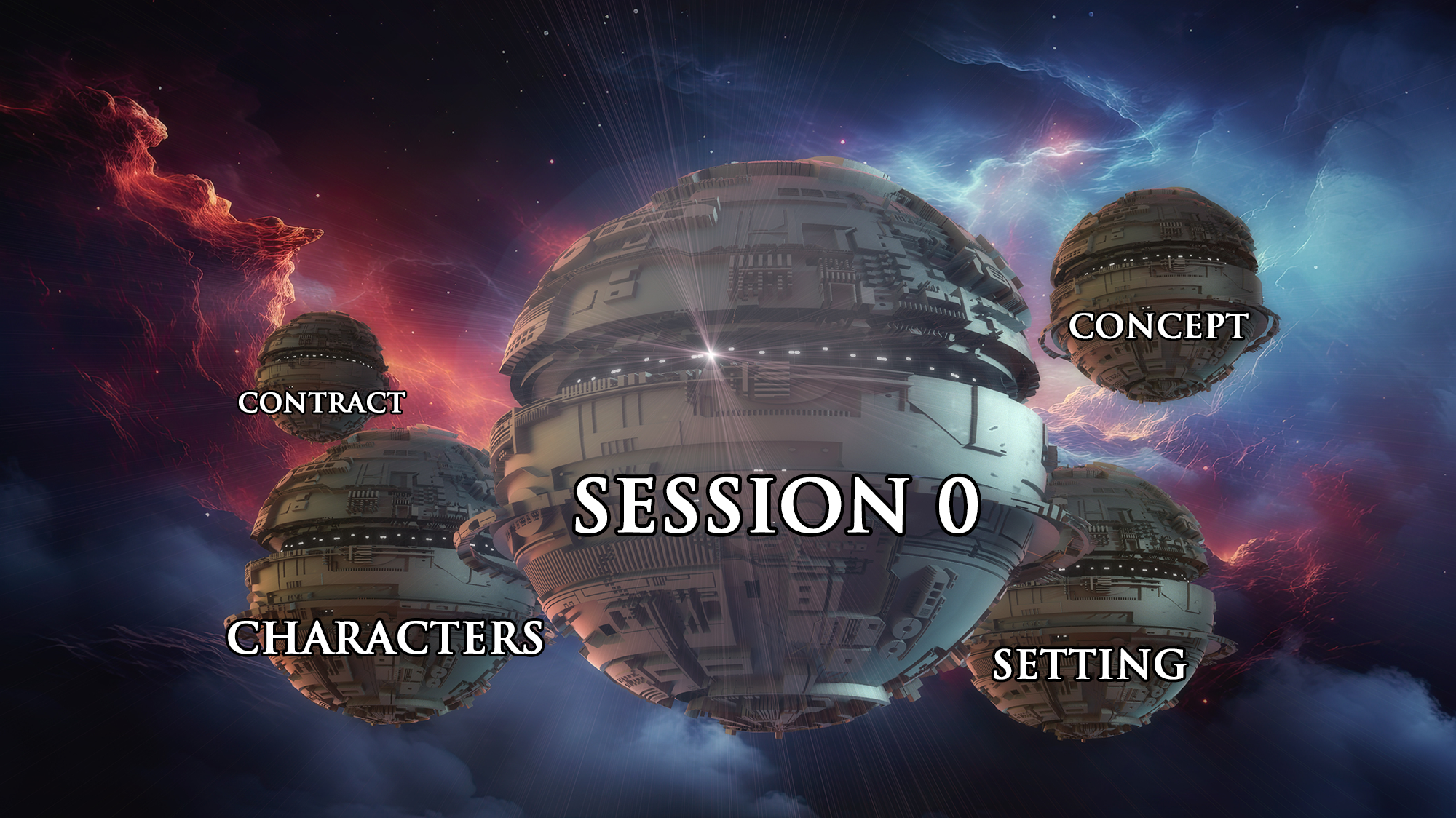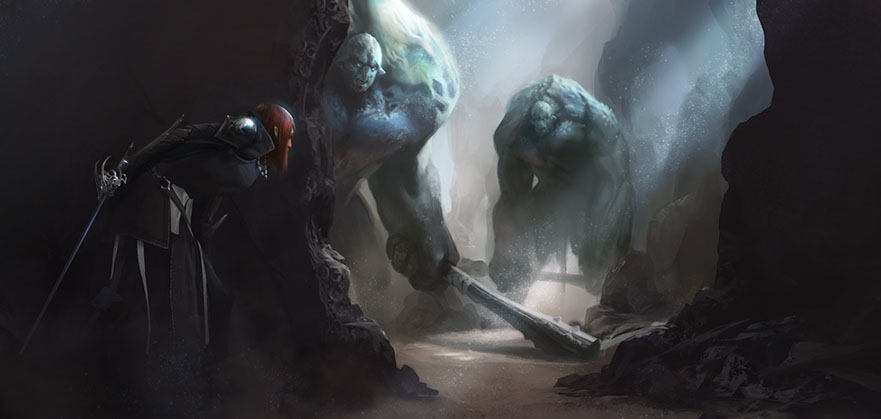When we sit down to play a roleplaying game, there’s always some amount of preparation we need to do before we can start slinging dice. What, exactly, that prep entails will depend on the game and the group, but we’ve come to call this prep — whatever form it takes — Session 0.
(The term originally referred strictly to a session dedicated entirely to prep without any actual game play happening. These days it’s often just referring to this prep in whatever form it takes, even if it’s only a few minutes covering the basics before diving into the evening’s adventure. For more on this background, you can check out The Evolution of Session Zero.)
For most RPGs, there are four core elements that need to be hashed out during Session 0.
THE GROUP CONTRACT
A group contract is the group’s formal and informal agreements about how the game will be run and played. This includes:
- Basic functions of play, such as the game rules and/or setting to be used. (Including the details of how the group will handle the other three core needs described below.)
- Narrative elements, such as script immunity, the rule of cool, whether genre conventions will trump simulation (or vice versa), themes, and tone.
- Safety tools, whether formal (X-cards, lines-and-veils, etc.) or informal.
- Real world logistics, such as “don’t leave the back door open,” “message the group chat if you’re going to be late,” how long game sessions will be, how scheduling will work, and “if you miss two sessions in a row, we sacrifice you to Bahlbaroth.”
This mutual understanding of how this specific game with these specific players is going to work is, surprisingly, almost entirely unspoken and completely unexamined in most groups. It’s kind of just assumed that the group will do what’s “obvious” or just “the way we’ve done it before.” That’s OK if it works, of course. Not so much if it means the group is ramming their faces into the walls.
(Never great, you’ll notice. “Great” would mean checking in on your unspoken, and often unrecognized, assumptions to make sure they actually make sense for the game you’re getting ready to run. Or, even better, optimized for it.)
CAMPAIGN CONCEPT
The campaign concept, broadly speaking, is who the PCs are and what they’ll be doing. For example:
- They’re retired spies who now use their particular set of skills to hunt a global conspiracy of vampires.
- They’re CSI agents investigating crime scenes in Chicago, IL.
- They own and operate a boutique specializing in magical unguents (for which they must gather the required ingredients from fairyland).
- They’re the organizers of a science fiction convention, and somehow every year there’s a supernatural catastrophe and they need to prevent it from derailing the con.
Sometimes picking a game is the same thing as picking a campaign concept (or close enough that it makes little difference). For example, D&D comes with the prepackaged expectation that the PCs are going to be wandering heroes in a classical fantasy setting who seek treasure and fight evil.
In other cases, though, just picking a game will still leave large chunks of the campaign concept uncertain. Jonathan Tweet’s Over the Edge, for example, assumes the campaign will be taking place on the conspiracy-riddled island of Al Amarja, but the PCs could be almost anybody and doing almost anything. The most extreme example of this can be found in a universal RPG like GURPS, the selection of which will tell the group absolutely nothing about what the campaign concept is.
(On the other hand, John Harper’s Lady Blackbird – which features a specific campaign hook and pregenerated characters slotted into that hook – is a game with an even more specific and hardcoded concept than D&D.)
It’s not unusual for the campaign concept to be predetermined by the GM, but it’s also possible for the concept to be developed by the whole group in collaboration. This can be as simple as the GM saying something like, “I’m going to be running a Mothership campaign in the Onyx-S5 cluster. Who are your characters and what are they doing there?” and then seeing where the discussion goes.
SETTING
Setting is inherently connected to the campaign concept: You can’t be space pirates if the campaign is set in 12th-century France, and if the campaign is set on Mars in the 22nd century, you won’t be playing Roman legionnaires. (Well… unless your GM is Harry Turtledove.) Whether setting flows from concept or concept flow from setting – e.g., whether you decide you want to play space pirates and then building a setting around that or decide you want to explore the setting of Middle Earth and then figure out what you want to do there – is really a chicken-or-the-egg situation, and will be different for every campaign.
(And, of course, it’s not at all unusual for the both setting and concept to be basically built up at the same time in tandem.)
Whatever the case may be – and whether there’s an established setting, a setting the GM has created for the campaign, or a completely original setting that’s being collaboratively generated during Session 0 – ultimately what’s needed is a setting brief with enough information about the setting that the players can create their characters.
This is often a lot less information than you might think. In fact, it’s often ideal to keep this information as minimal as possible: An infodump that’s too large can overwhelm the group, resulting in them actually knowing less about the setting, in practical terms, than a tight, well-focused briefing.
Check out So You Want to Be a Game Master and Random Worldbuilding: Fast & Furious Homebrewing for tips on creating effective setting briefings.
Just like the campaign concept, developing the setting can also be a collaborative process involving the whole table. There are some games that will actually formalize this collaboration into a more expanded form of character creation. Luke Crane’s Burning Empires, for example, is about the PCs facing an invasion of alien parasites, and the game’s mechanics will guide the group through creating the planet they live on.
CHARACTER CREATION
The final core element of your Session 0 is for the players to create their characters. This includes both mechanical character creation and their character background, each of which will also generally be connected to a character concept. Some players will start with a concept and then figure out how to model that concept mechanically and flesh out the details into a full-fledged background. In other cases, particularly when using systems featuring character generation instead of character crafting, players may start with the mechanics and use them as a creative prompt for who their character is going to be.
The mechanical aspect of character creation, of course, will be handled by whatever RPG is being played. Character backgrounds, on the other hand, tend to be more freeform in their development. (Although here, too, inspiration can flow from the mechanics into the background and vice versa. For example, if the player picks Sniper Training skill pack, that might inspire them to describe where the character got that training from. Or, vice versa, describing their character attending the US Army Sniper School at Fort Moore might prompt the player to pick the skill pack.)
Note: Another common point of debate here is the difference between minimalist backgrounds and expansive ones. This is really a spectrum, typically ranging from a couple of sentences to multiple pages of detailed character lore. Like everything else, the “right” approach will depend on the player, the group, the game, and the campaign. Regardless of length, though, the same basic creative process of concept, mechanics, and background will apply.
Whatever creative path players might follow here — and exactly what role the GM might take in collaborating with them to create their characters — there are a few key core tasks that need to be accomplished:
- Setting Integration. The players’ characters need to be linked to the setting. This is usually a two-way creative process: The players are drawing elements from the setting briefing — locations, people, events, etc. — to flesh out their character backgrounds, but they are also likely creating elements that the GM should be integrating into the setting.
- Campaign Integration. As characters are developed, the GM should begin the process of weaving them into the scenarios and campaign they have planned. In some cases the campaign will flow from the characters (e.g., the players decide their village was destroyed by someone called the Crimson Overlord, and the GM’s campaign planning is figuring out how they can pursue him for vengeance). In other cases, this will be about figuring out how to weave the PCs into the GM’s plan — e.g., the GM is planning a campaign in which the PCs are fighting a vampiric Triad in 1980’s Hong Kong, so when one of the players describes his PC’s martial arts master being slain by a mysterious man, the GM might decide to make the killer the undead Dragon Head of the Triad.
- Bringing the Group Together. Finally, the players should figure out why their PCs are a group (and, if necessary, the details of how that group will work in actual play). Maybe they’re old war buddies who’ve decided to open a detective agency together. Or maybe they all work for the same government agency. Or maybe they’ve all been framed for a crime and need to prove their innocence. Whatever the case may be, there should be a reason why all these PCs are sticking together. This may be something that’s discovered through play, but in most cases it’s better to figure it out as part of Session 0. (And even if you don’t, you’ll probably still want to have at least some indication of what trajectory the PCs are on that will cause their paths to collide and merge during the first session.)
Note how the setting, campaign concept, and the core tasks of character creation are all intertwined. Although you’ll probably want to lockdown some basic details about the campaign concept and setting before brainstorming character concepts, these generally aren’t tasks you can do one at a time. Instead, the group will be alternating between them, using setting to build concept and concept to build character and character to expand setting.
SESSION 0 MODULES
While we’ve looked at the core elements of a Session 0, it turns out there’s a nearly infinite number of different methods you can use to actually achieve them. I’ve previously laid out my default Session 0 procedure, which I’ve developed and refined over countless campaigns with a multitude of players.
But what I’ve also discovered while reading, running, and playing a bunch of different RPGs is that there’s a lot of really cool stuff you can do as part of Session 0. Some of these are highly specific and really only useful for the game they’re designed for. Others, though, have a near universal applicability: You could use them in D&D or Call of Cthulhu or Numenera or Apocalypse World.
The goal of this series is to share some of these techniques. I’m calling them Session 0 Modules, because they’ve been designed — or adapted — to be things you can independently plug into your Session 0.
This also means that the intention is NOT for you to take all of these modules and use them in every single Session 0 you run. That would be overwhelming at best, and not infrequently contradictory. Instead, when getting ready to run a new campaign, peruse these modules as if they were a menu, thinking about which ones would be most useful — or most appropriate — for your group.
You could also think of these modules as a spice rack. Start with a core Session 0 procedure that works for you and yours, but then toss in one or two of these modules to mix things up. This might be something you plan ahead of time as part of your campaign prep, but you could also find yourself reaching out in the middle of a Session 0 to grab a module that you never would have imagined needing until the players started creating their characters.
In other words, these tools. Use them when you need them. Ignore them when you don’t.
CHARACTER MODULES
This will be an ongoing series at the Alexandrian, with new modules being added over time.

















